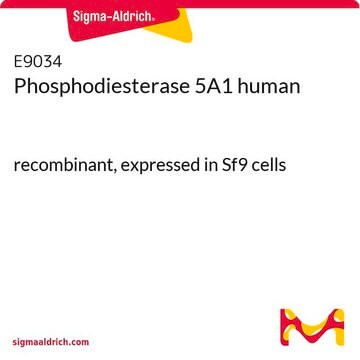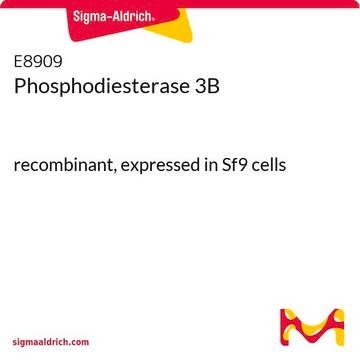P9041
Phosphodiesterase II from bovine spleen
lyophilized powder, ≥5.0 units/mg protein
Sinónimos:
3′-Exonuclease, Spleen exonuclease, Spleen phosphodiesterase
About This Item
Productos recomendados
form
lyophilized powder
specific activity
≥5.0 units/mg protein
mol wt
65 kDa
UniProt accession no.
foreign activity
5′-Nucleotidase ≤1% of base activity
storage temp.
−20°C
Gene Information
cow ... PDE2A(281971)
General description
Application
- excision of pyridyloxobutyl (POB) base adducts from DNA
- digestion of DNA prior to cycloadenosine enrichment
- hydrolysis of DNA from blue mussels gill tissue into deoxyribonucleoside 3′-monophosphates
Biochem/physiol Actions
Polynucleotides having 5′-phosphomonoester end groups are not attacked.
Unit Definition
Analysis Note
Storage Class
10 - Combustible liquids
wgk_germany
WGK 3
flash_point_f
Not applicable
flash_point_c
Not applicable
ppe
Eyeshields, Gloves, multi-purpose combination respirator cartridge (US)
Certificados de análisis (COA)
Busque Certificados de análisis (COA) introduciendo el número de lote del producto. Los números de lote se encuentran en la etiqueta del producto después de las palabras «Lot» o «Batch»
¿Ya tiene este producto?
Encuentre la documentación para los productos que ha comprado recientemente en la Biblioteca de documentos.
Los clientes también vieron
Nuestro equipo de científicos tiene experiencia en todas las áreas de investigación: Ciencias de la vida, Ciencia de los materiales, Síntesis química, Cromatografía, Analítica y muchas otras.
Póngase en contacto con el Servicio técnico









